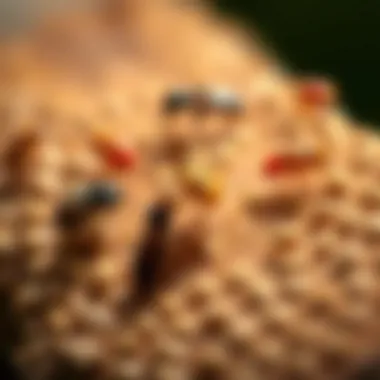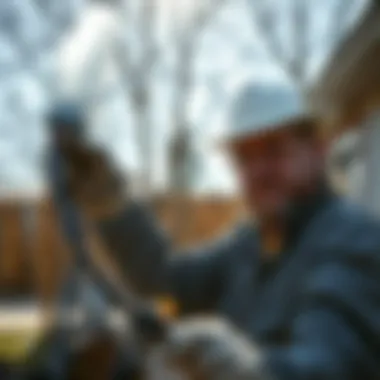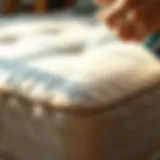Effective Pest Control Strategies for Mattoon, IL


Intro
In Mattoon, Illinois, the changing seasons and lush landscapes provide a beautiful backdrop for homes, but they also create ideal conditions for various pests. From the buzz of a fly to the scuttle of a mouse, these unwelcome guests can quickly disrupt the comfort of your living space. Understanding pest behavior and habits is crucial for effective pest management, whether you’re taking the matter into your own hands or enlisting professional help.
Through this guide, we will navigate the intricacies of pest control, specifically tailored for the Mattoon area. This will not only include identification of common pests and signs of their presence but also offer practical prevention methods, DIY solutions, and insight on when it’s time to reach out to professionals. With a focus on sustainable practices and eco-friendly solutions, we aim to equip homeowners with the necessary tools to address pest issues responsibly and effectively.
Let’s dive into the first section, concentrating on how to accurately identify the pests that might be lurking in your home.
Pest Identification
Common Household Pests
Understanding the types of pests commonly found in Mattoon is key to effective management. Here are some of the most prevalent offenders:
- Ants: Various species, including carpenter and sugar ants, are frequent visitors. They often invade kitchens in search of food.
- Cockroaches: Known for their resilience, these critters can thrive in many conditions, often found in warm, humid areas.
- Termites: A significant threat to wooden structures, they can go undetected until they’ve caused extensive damage.
- Rodents: Mice and rats are not only nuisances but can also pose health risks; they are adept at squeezing into tight spaces.
- Spiders: While many spiders are harmless, their presence can still cause discomfort for some homeowners.
Signs of Infestation
Detecting the early signs of pest activity can save you time and money. Look out for:
- Small droppings around food sources or nests.
- Damage to wood or insulation, particularly in the case of termites.
- Unexplained holes in walls or food containers.
- Seeing insects themselves, of course; a sighting of a cockroach might indicate a larger problem.
- Unusual odors that may signal the presence of rodents.
The sooner you notice these signs, the quicker you can take action to mitigate any potential problems.
Prevention Methods
Environmental Modifications
Keeping pests at bay starts with making simple modifications around your property. Consider these approaches:
- Seal Entry Points: Small gaps in windows, doors, and foundations can allow pests to slip inside. Inspect your home for these vulnerabilities and seal them up.
- Maintain Yard Hygiene: Keeping your garden clean and trimmed can deter pests. Remove debris, such as leaves or wood piles, where pests might thrive.
- Proper Drainage: Stagnant water attracts a variety of pests, particularly mosquitoes. Ensure that gutters are clean and water doesn’t accumulate.
Home Maintenance Tips
Regular upkeep can prevent pests from turning your home into theirs:
- Regular Cleaning: A clean home is less inviting for pests. Pay close attention to areas like the kitchen and pantry.
- Storage Solutions: Store food in sealed containers, and avoid leaving pet food out overnight.
- Routine Inspections: Regularly check for signs of pest activity or conditions that may favor their entry.
DIY Pest Control Solutions
Natural Remedies
For those opting for eco-friendly methods, natural remedies can be effective. Consider:
- Vinegar Solutions: A mixture of vinegar and water can be used to repel ants.
- Essential Oils: Scents like peppermint or eucalyptus can act as natural deterrents, particularly for spiders and insects.
- Boric Acid: Used against cockroaches and ants, it can be sprinkled in areas where pests are likely to wander.
DIY Traps and Barriers
Creating your own traps can help manage pest issues without chemicals:
- Sticky Traps: You can easily make traps with a piece of cardboard coated in honey or syrup to catch insects.
- Homemade Baits: For rodents, a mixture of peanut butter and baking soda can entice them, and the baking soda can eliminate them.
Taking control of pest problems can be manageable and even satisfying. The next step involves knowing when to contact professionals. Stay tuned as we unravel more insights on this essential topic!
Prologue to Pest Control
When it comes to maintaining a safe and healthy home environment, understanding pest control is fundamental. Many people often underestimate the significance of effective pest management; they might think it's just about getting rid of the occasional ant or roach. However, pests can lead to serious health risks and property damage if not handled promptly and properly. This introduction sets the stage for a deeper dive into pest control in Mattoon, IL, where local conditions can significantly influence pest types and the strategies required to manage them.
Understanding Pest Control
The concept of pest control revolves around the methods and practices aimed at managing or eliminating pests that threaten human health or property. This involves identifying pests accurately, assessing their impact, and determining the best strategies to control their populations. In Mattoon, unique climatic and environmental factors affect the type of pests residents encounter. Pest control isn't merely about extermination; it's about understanding the lifecycle and behavior of pests, allowing for more targeted and effective solutions.
Moreover, pest control can encompass various approaches ranging from preventive measures to chemical treatments. Educating ourselves about these aspects contributes to making informed decisions that benefit both health and the environment. An essential part of this understanding is recognizing the interconnectedness of pest populations, human activity, and the local ecosystem. If we know how pests operate, we can effectively manage them while minimizing unnecessary disruption to our surroundings.
Importance of Effective Pest Management
Effective pest management yields several beneficial outcomes. Firstly, it protects public health; pests like rodents and cockroaches are notorious for harboring diseases that can propagate in populations. For instance, rodents can carry hantavirus while cockroaches may contribute to asthma in sensitive individuals, particularly children. Ensuring that these pests are managed effectively reduces the risk of disease transmission.
Secondly, pest control plays a significant role in protecting property. Many pests can cause considerable damage, ranging from the structure of buildings to the integrity of food supplies. Termites, in particular, are a silent adversary that can compromise wooden structures before they're ever noticed. By employing effective pest management strategies, homeowners safeguard their investments.


In addition, tackling pest issues proactively can save homeowners money in the long run. Instead of paying for costly emergency treatments, early intervention usually proves more cost-effective. Furthermore, many pest control methods today emphasize sustainability, implementing practices that protect beneficial insects and the broader environment.
"Investing in pest control is not just about dealing with a nuisance; it’s about preserving your home and health for years to come."
In summary, pest control goes beyond merely ridding a space of unwanted guests. It requires a comprehensive understanding and strategic approach to ensure that homes and health remain protected. This article will further explore common pests specific to Mattoon, methods for prevention, effective DIY solutions, and when it might be time to call in the pros.
Common Pests in Mattoon,
Understanding the common pests that plague Mattoon, IL, is essential for homeowners. Knowledge of these critters not only aids in identifying potential issues but also in developing effective control strategies. With local environmental factors at play, certain species may thrive here more than in other areas. Understanding what you may encounter can help you act swiftly to protect your home. Let's dive deeper into the most prominent pests in this region.
Rodents: Identification and Challenges
Rodents are a persistent problem in many households, and Mattoon is no exception. The two most common culprits include the house mouse and the roof rat, both of which can invade the home, creating a myriad of problems. House mice are small, typically brown or grey, with large ears and a pointed nose. They can squeeze through tiny openings, making identification tricky until they’ve made a mess.
Roof rats, on the other hand, are slightly larger and can often be found in attics or upper areas of homes. They are black with a slender body and a long tail. One major challenge posed by rodents is their rapid reproduction rate; a pair of mice can escalate to hundreds in just a few months if not controlled.
Here are some signs to look out for:
- Scratching noises in the walls or attic, especially at night.
- Droppings in corners or near food sources, often appearing like small black pellets.
- Nesting materials, which can include shredded paper or fabric, often found in hidden locations.
If you suspect a rodent infestation, acting quickly is vital. Not only can they cause structural damage, but they can also carry diseases that pose health risks to humans.
Insects: Types and Behavior
Insects form another significant part of the pest landscape in Mattoon. You'll encounter various species, but some of the most notorious include ants, cockroaches, and mosquitoes. Each insect has its unique behavior, requiring tailored approaches to manage them effectively.
Ants, especially carpenter ants, invade homes not only for food but also for nesting. They usually leave a trail of pheromones, leading you back to their nest. In contrast, cockroaches are more stealthy, thriving in hidden areas. They are resilient and reproduce quickly, making them hard to eliminate. And then we have mosquitoes. Known for their irritating bites, they breed in standing water. Addressing mosquitoes often means cleaning up their breeding grounds around your property.
Here’s a quick rundown of some common insects to watch for:
- Ants: Look for trails and small holes in wooden structures.
- Cockroaches: Check sinks, cabinets, and nightstands for signs.
- Mosquitoes: Be aware of standing water in gardens.
Termites: A Silent Threat
Ah, termites—the stealthy destroyers of homes. Often referred to as the "silent threat," these pests can cause enormous damage before any visible signs appear. In Mattoon, the most common termite species found is the Eastern subterranean termite. They are known for tunneling through wood, compromising not only the aesthetics of your home but its very structure as well.
Since they thrive in dark, moist environments, they tend to stay hidden. Homeowners should be on the lookout for mud tubes, which are a clear indication of a termite colony.
Some key indicators of a termite infestation include:
- Hollow-sounding wood when tapped.
- Swarming termites during warmer months.
- Discarded wings around home windows or doors.
To combat termites, regular inspections are necessary. Catching them early can save you a significant headache and dollars in repair costs.
Understanding these pests is the first step in effective pest control. Knowledge empowers you to create strategies tailored to your particular situation in Mattoon, IL.
Prevention Techniques for Homeowners
Effective pest control begins long before any signs of infestation arise. For homeowners in Mattoon, IL, adopting preventive measures can save significant time, effort, and money in the long run. Prevention techniques serve as the first line of defense against pests. By implementing simple strategies, you not only reduce the likelihood of infestation but also create an environment that is less appealing to pests. This proactive approach is key to maintaining a comfortable home.
Sealing Entry Points
One of the most crucial steps in pest prevention is sealing entry points throughout your home. Pests are crafty; they can squeeze through the tiniest cracks or gaps. Inspect your home’s exterior for potential openings. Common areas that often go unnoticed include:
- Around windows and doors
- Where pipes enter the building
- Attic vents and basement openings
- Gaps at the foundation
Using caulk or expandable foam can effectively close these gaps. In areas with larger openings, consider installing screens or using steel wool for extra precautions. Remember, if you can see light peeking in, there might be a pest trying to get out.
Proper Waste Management
Pests have a knack for finding food sources, and what better place than your garbage? Proper waste management is paramount in pest control. Here are a few steps to make your rubbish less appealing to unwanted guests:
- Secure Lid: Always keep waste bins covered with tight-fitting lids.
- Clean Up: Regularly clean the area around your bins to remove food residues.
- Compost Wisely: If you compost, be mindful of what you add. Avoid including meats or dairy that can attract unwanted visitors.
Proper waste management not only helps in keeping pests at bay but also contributes to a cleaner, healthier environment.
Maintaining Cleanliness
A clean home is a happy home, and it’s certainly less attractive to pests. By maintaining cleanliness, you can greatly reduce the odds of an infestation. Here are a few simple guidelines to follow:


- Regular Cleaning: Ensure that you sweep and vacuum regularly, especially in hidden areas where crumbs tend to gather.
- Food Storage: Store food in airtight containers, and keep your pantry organized and free of spills.
- Declutter: Limit clutter in your home. Pests love hiding spots, so the less clutter, the better.
Participating in these practices creates a more inhospitable environment for pests and makes your home healthier overall.
"Prevention is better than cure," they say, and this rings especially true when it comes to pest control. Taking the initiative now can spare you future headaches.
Effective DIY Pest Control Methods
When it comes to pest control, many homeowners prefer to take matters into their own hands. Effective DIY pest control methods not only save you from the potential cost of hiring professional services, but they can also empower you with the knowledge and skills to tackle pest issues head-on. In this portion of the guide, we will explore various approaches that you can implement to keep your home pest-free, focusing on natural remedies, traps, baits, and homemade sprays.
Natural Remedies and Solutions
Natural remedies can be remarkably effective in keeping unwanted pests at bay. Many store-bought pesticides contain harsh chemicals that can be detrimental to your health and the environment. Instead, consider these easy-to-find ingredients you might already have at home:
- Vinegar: A strong odor can repel many insects. Mix equal parts of water and vinegar to create a mixture that can be sprayed around entry points.
- Essential Oils: Oils like peppermint or eucalyptus not only smell good but can also deter pests like ants, spiders, and mosquitoes. A few drops mixed with water can be a simple yet beneficial spray.
- Boric Acid: This naturally occurring mineral is particularly effective against cockroaches and other insects. Sprinkle some in areas where you've seen these pests, being mindful to keep it away from pets and children.
Using these methods can be a safer and often more pleasant way to manage pest control without the need for chemical solutions.
Traps and Baits
Traps and baits are tried-and-true options for homeowners looking to manage pests effectively. These devices can target specific insects or rodents and can be set up in various locations around the house. Here are some popular options:
- Glue Traps: These can be particularly effective for small rodents and insects. Place them near suspected entry points or along walls, where pests are likely to travel.
- Snap Traps: Commonly used for rats and mice, these traps deliver a quick action to neutralize the threat. Bait them with peanut butter, which is appealing and effective.
- Bait Stations: For ants, bait stations can be an efficient way to deal with infestations. The worker ants take the bait back to their colony, ideally harming the entire community.
Make sure to check the traps regularly to dispose of trapped creatures humanely and safely.
Home-Made Sprays and Chemicals
Creating homemade sprays can be both economical and effective for pest management. Unlike commercial products, these solutions often use fewer chemicals, which can be beneficial for your family’s health. Here are a few recipes that you might find useful:
- Pepper Spray: Combine one tablespoon of crushed red pepper with water in a spray bottle. This can deter unwanted visitors like spiders and ants.
- Soap and Water: Mixing liquid soap and water can help control soft-bodied pests like aphids and spider mites. Spray directly onto the pests to eliminate them quickly.
- Citrus Spray: Many insects dislike citrus. Use lemon peels steeped in water to create a natural spray that can fend off a variety of bugs.
These strategies not only help manage pest situations but also keep your home environment more chemical-free.
Takeaway: Implementing DIY methods encourages self-sufficiency and can foster a deeper understanding of pest dynamics within and around your home.
Adopting some of these DIY pest control methods allows for proactive management of common pest issues while being aware of both health and environmental impacts. It might take a bit of trial and error to find the best approach for your specific situation, but in the long run, these practices could save you time, resources, and angst.
For more information on homemade pest control methods and natural solutions, you can explore resources at Wikipedia or check out community discussions on Reddit.
Professional Pest Control Services
Engaging a professional pest control service can feel like a daunting task, but it’s often the best route for homeowners grappling with persistent pest issues. In Mattoon, IL, where certain pests can wreak havoc on properties, these services bring expertise and efficiency that DIY methods may lack. Choosing the right company can save time, eliminate the guesswork, and ensure safety throughout the process.
Choosing a Pest Control Company
When selecting a pest control company, the first step is to conduct thorough research. Check for local providers that come equipped with a solid reputation and customer reviews. In Mattoon, you might want to look for companies like Terminix or Orkin whose services are tailored to the specific pest challenges in the area.
- Credentials & Licensing: Ensure the company has proper licensing. In Illinois, pest control operators must be licensed by the Illinois Department of Public Health. This ensures adherence to safety and efficacy standards.
- Experience and Specializations: Experience is key. Inquire about how long they’ve been in business and whether they specialize in pests commonly found in Mattoon, such as termites or rodents.
- Customer Service: A reliable company will offer excellent customer service, from clear communication before you sign any contracts to responsiveness to your concerns. A swift response in an emergency, like a bed bug infestation, is vital.
What to Expect from Professionals
Once you've chosen a pest control service, it's good to know what to expect. The first visit usually involves a thorough inspection of your property. Professionals will look for signs of pest activity, entry points, and potential breeding grounds. Expect a discussion about your pest problems and creating a tailored plan.
- Assessment: A detailed analysis of your property and pest issues is conducted.
- Treatment Plan: Based on the assessment, a specific treatment plan is proposed, which could involve chemical and non-chemical methods.
- Follow-Up Visits: Most reputable services will schedule regular follow-ups to monitor the situation and apply further treatments if necessary. This ongoing evaluation is essential for long-term pest management.
Professional pest control often goes beyond just exterminating pests. It involves managing the environment to prevent future infestations, providing peace of mind for homeowners.
Cost Considerations
Cost is always a factor to ponder when seeking professional pest control services. The expenses can swaying based on an array of elements, including the type of pest problem, the size of the property, and the treatment employed.
- Initial Inspection Costs: Many companies might offer a free initial inspection, while others may charge a fee. This is an important step to grasp the scope of the infestation.
- Treatment Costs: Depending on whether you have a minor issue or a major infestation, costs might range from a couple hundred to several thousand dollars. Multi-faceted treatments, especially for ongoing issues like termites, can climb higher.
- Contracts and Guarantees: Be wary of contracts that tie you down without clear benefits. Many companies offer guarantees for their services, meaning if the pests return after treatment, they will come back at no additional charge.
In summary, using a professional pest control service can be not just about eradicating pests but about developing a long-term relationship for maintenance and peace of mind. Finding the right company and understanding the financial implications can ultimately lead you to a pest-free home.
Sustainable Practices in Pest Control
Pest control, while necessary to maintain our homes and health, needs to be approached with a certain level of care for our environment. Sustainable practices in pest control encompass a variety of methods and strategies that minimize harmful effects on the ecosystem while effectively tackling pest infestations. Emphasizing sustainability is important because it addresses both current pest issues and long-term environmental health, ensuring that future generations can also enjoy a clean and safe living environment.


The benefits of using sustainable pest control methods are manifold. They often lead to reduced chemical exposure for your family and pets, preserve beneficial organisms in your garden, and mitigate the risk of pesticide resistance. In Mattoon, where maintaining the local biodiversity is critical, these practices become even more relevant. Homeowners who opt for sustainability in pest management often find that their gardens flourish alongside healthy pest management.
Eco-Friendly Methods
Incorporating eco-friendly methods into pest control involves leveraging natural solutions instead of conventional chemical treatments. These methods can include:
- Natural Predators: Utilizing the natural predators of common pests, such as ladybugs for aphids or nematodes for soil pests, helps keep pest populations in check without chemicals.
- Companion Planting: Some plants naturally repel pests or attract predators. For instance, marigolds can deter nematodes, while basil can ward off flies.
- Essential Oils: Utilizing essential oils like peppermint or tea tree can repel certain pests. These plant-based oils can be mixed with water and applied in areas where pests tend to gather.
Homeowners should consider these methods as viable alternatives that are safer not only for the environment but also for those living in and around treated areas, especially children and pets.
Impact of Chemicals on Environment
Chemical pesticides, while effective in the short term, can have far-reaching impacts on the environment. They can leach into soil and waterways, affecting wildlife, plants, and even drinking water sources. Additionally, the overuse of certain chemicals may lead to pesticide resistance in pest populations, creating a vicious cycle of dependency on stronger and potentially more harmful substances.
Some of the notable impacts include:
- Harm to non-target species, including beneficial insects and pollinators like bees.
- Contamination of groundwater, which can affect drinking supplies.
- Disruption of local food webs and ecosystems.
As responsible homeowners, it's vital to be informed about these risks and to consider sustainable alternatives. It's worth repeating that what may seem like a quick fix can yield longer-term consequences for your surroundings. Awareness can lead to better choices in pest management.
Integrated Pest Management (IPM) Strategies
One of the most effective principles of sustainable pest control is Integrated Pest Management (IPM). IPM is a holistic approach that combines various management strategies and practices to control pests in an environmentally sound manner. It focuses on:
- Monitoring: Regularly observing pest populations and damage to determine if action needs to be taken.
- Prevention: Implementing practices that reduce the likelihood of pest infestations, such as proper sanitation or habitat modification.
- Control Methods: Using a combination of cultural, biological, and chemical controls when necessary.
Implementing IPM in Mattoon can not only lead to effective pest management but can also foster a more significant respect for local ecosystems. Homeowners can participate in community efforts to monitor and share information about pest populations and management strategies, aiding both their own experiences and contributing to collective local knowledge.
In summary, adopting sustainable practices in pest control is a prudent decision that aligns pest management with environmental stewardship. By using eco-friendly methods, understanding the impacts of chemicals, and employing Integrated Pest Management, homeowners in Mattoon can create a balanced approach that protects both their homes and the environment.
Legal Regulations on Pest Control in Illinois
In the realm of pest control, understanding the legal landscape is as vital as knowing the pests themselves. Regulatory frameworks help ensure that pest management practices are safe, effective, and environmentally sound. For homeowners in Mattoon, IL, grasping these regulations can resonate in multiple ways—from ensuring safety to promoting ecological sustainability. Navigating the intricacies of these laws can mean the difference between a successful pest management strategy and one that potentially causes harm.
Licensing Requirements for Pest Control Operators
Licensing serves as a foundational pillar in the pest control industry. In Illinois, the Department of Public Health oversees licensing for pest control operators, ensuring they meet specified competency standards before they can offer their services.
To obtain a license, pest control operators must typically:
- Complete Training: Operators often undergo educational programs that cover the biology of pests, control strategies, and safe usage of pesticides.
- Pass an Examination: A written test assesses their knowledge on various aspects of pest management and safety protocols.
- Carry Liability Insurance: This ensures they can cover potential damages or incidents arising from their services.
"Not just any Joe Blow can come into your home, armed with spray cans and traps. It’s about ensuring the pros know their stuff!"
For home and property owners in Mattoon, verifying the certification of pest control operators they hire can save headaches down the line. Always ask to see a copy of their license or check with the Illinois Department of Public Health to confirm its validity. Knowing this can give you peace of mind, knowing that trained professionals are handling your pest problems.
Environmental Regulations and Compliance
When we talk about pest management, we can’t overlook the elephant in the room: environmental impact. In Illinois, there are stringent environmental regulations regarding pesticide use. These regulations are designed to protect natural resources, including air, water, and wildlife.
Before using chemicals, pest control specialists must adhere to essential guidelines such as:
- Proper Application: Pesticides must be applied in a way that minimizes exposure to non-target organisms and prevents runoff into waterways.
- Record Keeping: Operators are required to maintain accurate records of pesticide applications, including dates, amounts, and targeted pest species. This transparency ensures accountability.
- Adherence to Label Directions: Each pesticide product comes with an accompanying label outlining safe usage, storage, and disposal methods. Compliance is not just mandated; it's critical for safety.
Ignoring these regulations can lead to environmental degradation and even legal repercussions for pest control businesses. Homeowners should inquire whether the companies they hire follow these protocols.
Ending and Future Directions
Navigating the world of pest control is no small task, especially in unique areas like Mattoon, Illinois. This guide has shed light on aspects ranging from common local pests to proactive prevention techniques. As we wrap up, it's vital to highlight a few key takeaways as well as where the industry might be headed in the future.
Summarizing Effectiveness of Pest Control Strategies
The effectiveness of pest control strategies hinges primarily on their adaptability to specific situations. Continued education and practical understanding play crucial roles in the success rates seen in most households. Homeowners must recognize that what works for one home might fall flat for another due to varying factors such as the distinct environments, pest types, and human habits.
For example, some might find that sealing entry points is a reliable method, while others should focus on maintaining a meticulous cleanliness around living spaces. It becomes clear that effective pest control is not a one-size-fits-all solution but rather a multifaceted approach – one that’s tailored.
Additionally, many DIY methods can be remarkably effective if used correctly and at the right times. However, an important point to consider is the balance between personal effort and professional intervention. When pests are persistent, or if they could cause significant damage, calling in the pros is generally the wisest choice.
"A stitch in time saves nine." In pest control, timely attention prevents minor issues from escalating into major headaches.
The Role of Technology in Pest Management
Looking to the future, technology is set to play a transformative role in pest management. Advanced tools like smart traps, which utilize sensors and artificial intelligence to monitor pest activity, offer homeowners an unprecedented level of insight. Imagine being alerted via phone when a pest enters your home instead of discovering a problem too late.
Moreover, the integration of automated systems into pest control can streamline daily routines for homeowners. For instance, some smart systems can be programmed to manage indoor pest prevention by triggering specific deterrents based on environmental cues.
Sustainable technology is also taking the lead, complementing eco-friendly pest control strategies. Innovations, like targeted drone applications for outdoor pesticide treatments, provide a high degree of precision that minimizes environmental impacts.















